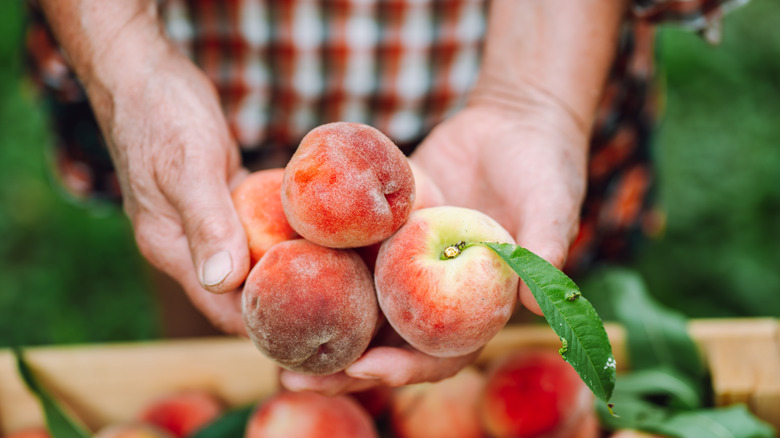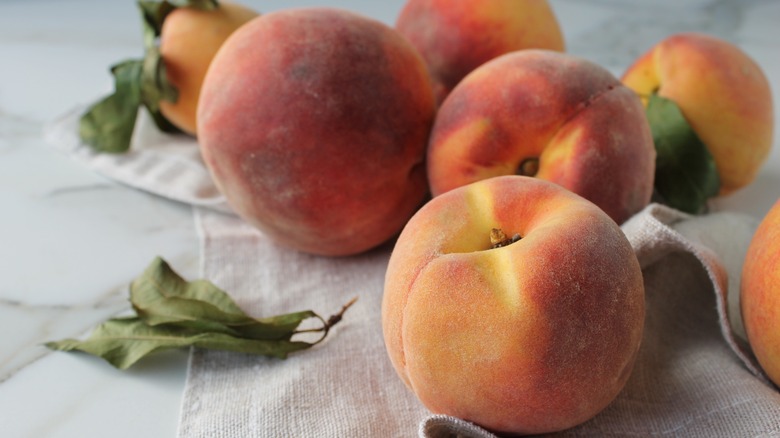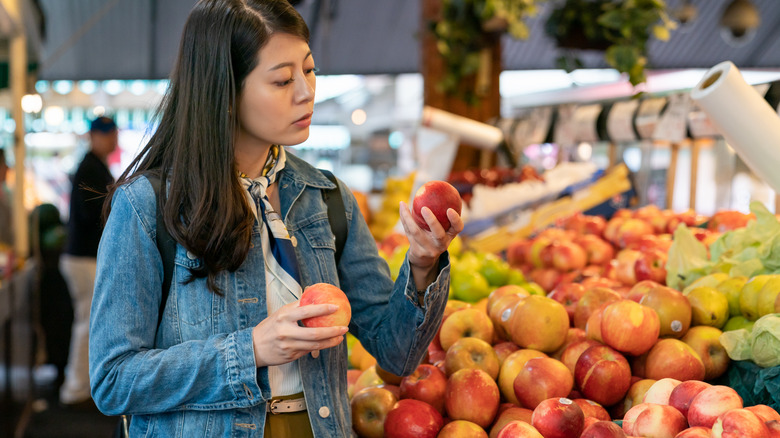Yes, There Is A Correct Way To Store Peaches
There are plenty of times when preserved peaches are perfectly fine. For example, canned peaches are perfect for making a delicious crisp, and those same canned peaches are also a great way to upgrade your BLTs. They'll do in different circumstances, sure, but when peaches are in season and hit your local produce aisle or farmers' market, there's nothing that can compare. You're going to want to pick up a sack full of these delicious fruits, but what happens when you get them home?
You've probably heard the oft-repeated wisdom that they should be kept in the fridge once they're ripe, and the theory is that the cold temperature will help keep them from spoiling and ripening past their prime. But that's actually not the case, and experts say that the fridge should be a last resort.
Those in-the-know suggest that keeping peaches on the counter is the way to get the most out of these succulent, sweet fruits, and say that you definitely shouldn't put them in the fridge at all — or, at least not for more than a day or two. With that in mind, let's take a closer look at just how to get the most out of your fresh peaches by storing them properly.
The kitchen counter is the best option for fresh peaches
For starters, let's talk about the peaches that aren't quite ripe enough to eat yet. If you're in a hurry, you should put them in a brown paper bag and keep them out of direct sunlight. Check them after a day or two, and why does this work? As peaches ripen, they release a gas that encourages ripening, and keeping them in a paper bag creates the perfect, ethylene-rich environment.
Keep in mind, though, that you should limit the number of peaches in the bag: They bruise easily. Similarly, if you're happy to let them ripen on their own, just put them in a similarly shady place in the kitchen, preferably not stacked or in a bowl. Those unripe peaches definitely don't belong in the fridge, as they'll not only ripen very slowly, but they'll become dehydrated, discolored, and the opposite of what fresh peaches should be.
Once they're ripe, there's two schools of thought. While many will say they can be then put into the fridge to keep them fresh longer, the best thing is to eat them immediately and at room temperature. That's when they'll be at their sweetest, and since the fridge can have a negative impact on flavor and water content, you'll end up with cold peaches that aren't nearly as sweet or juicy as they could have been. Leave those ripe peaches on the counter!
Choose peaches at varying stages of ripeness
If you count on the refrigerator to slow down the ripening process of peaches so you're not overwhelmed at once, there's an easy way to avoid this: Simply select peaches that are in different stages of ripeness, which is almost surprisingly easy to do.
When you pick up a peach, there's a few telltale signs that you're looking for. Gently squeeze the peach, and if there's only a slight bit of give, those are the ones that will be ready in about a week or so. The more give there is, the riper they are: If they're soft, they'll be ready to eat over the next few days. If your finger leaves a gentle bruise, they're ready to eat ASAP, and if they're already bruised when you pick them up, they're over-ripe. They're probably still fine to eat, but they won't be for much longer. Also, look for peaches that have a strong, fresh smell, and if they don't smell delicious, try to sniff out better options.
Steer clear of peaches that are very hard, have no give, or have a greenish tint to them, particularly around the stem. That means they were picked when they were too young and well before they were ready, and even if they do ripen, they're likely to be mealy. Taking the time to pick the right peaches might seem like a hassle, but you'll appreciate it when you're enjoying something like a delicious Kentucky bourbon peach shortcake!


